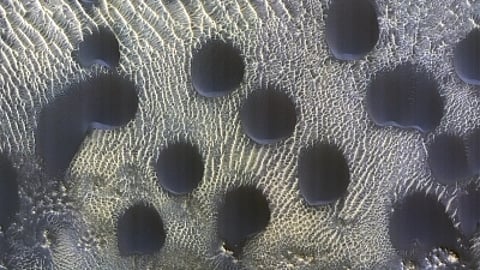
- Home
- न्यूजग्राम
- India
- World
- Politics
- Entertainment
- Culture
- Lifestyle
- Economy
- Sports
- Sp. Coverage
- Misc.
- NewsGram Exclusive
- Jobs / Internships

While sand dunes of many shapes and sizes are common on Mars. The MRO captured "dunes that are almost perfectly circular, which is unusual," wrote planetary geologist Alfred McEwen for a HiRise picture-of-the-day feature.(File Photo/IANS)
Sand Dunes on Mars
NASA's Mars Reconnaissance Orbiter (MRO) spacecraft has captured unusual circles of sand dunes on the Red Planet.
The dunes were snapped by MRO's High-Resolution Imaging Experiment (HiRise) color camera.
While sand dunes of many shapes and sizes are common on Mars. The MRO captured "dunes that are almost perfectly circular, which is unusual," wrote planetary geologist Alfred McEwen for a HiRise picture-of-the-day feature.
While being circular, "they are still slightly asymmetrical" and have "steep slip faces on the south ends," McEwen wrote.
He explained that this indicates that "sand generally moves to the south, but the winds may be variable".
The dunes were snapped in late November last year - when researchers were studying the area to monitor for seasonal changes in frost coverage. This image shows frost is absent from the landscape.
MRO, which has higher-resolution instruments than Odyssey, was launched in 2005. It has studied the Red Planet's atmosphere and terrain from orbit since 2006 and also serves as a key data relay station for other Mars missions.
Equipped with a powerful camera called HiRISE that has aided in several discoveries, the MRO has sent back thousands of stunning images of the Martian surface that are helping scientists learn more about Mars, including the history of water, flows on or near the planet's surface. (KB/IANS)
